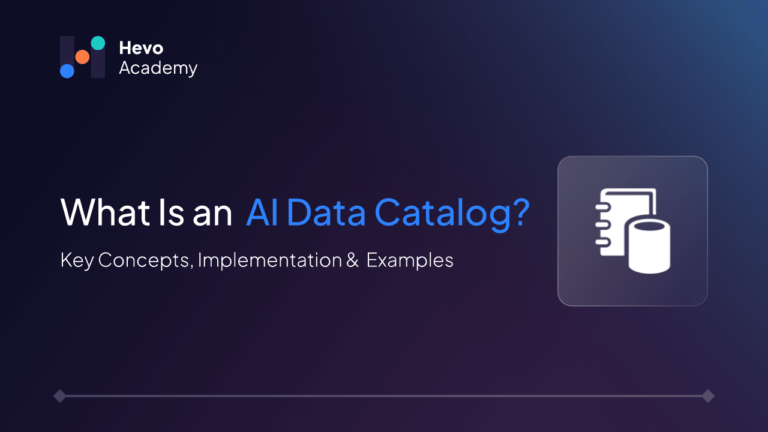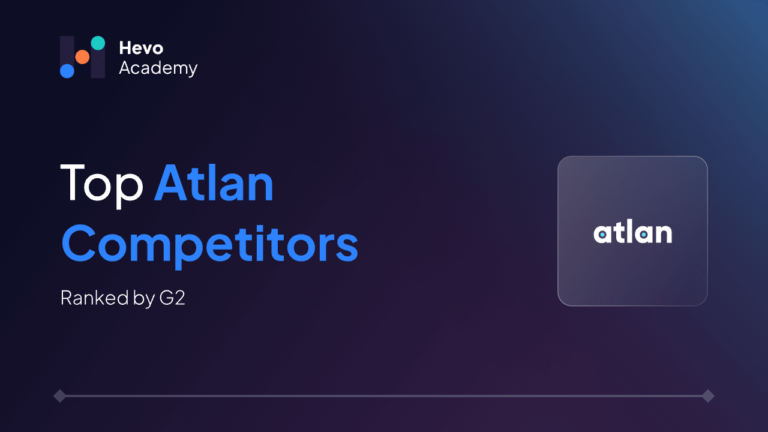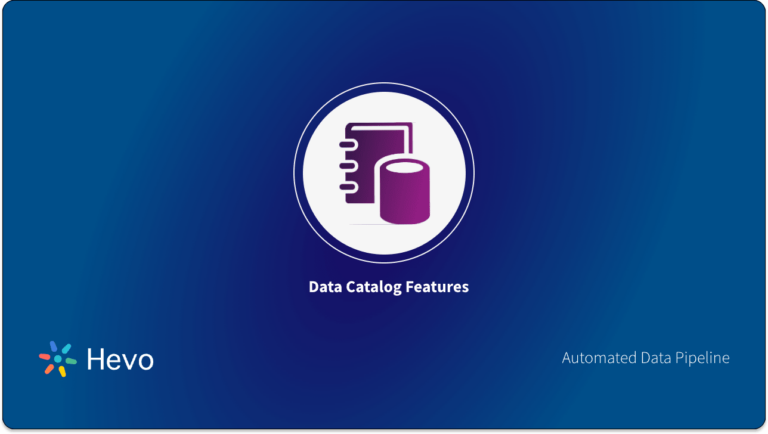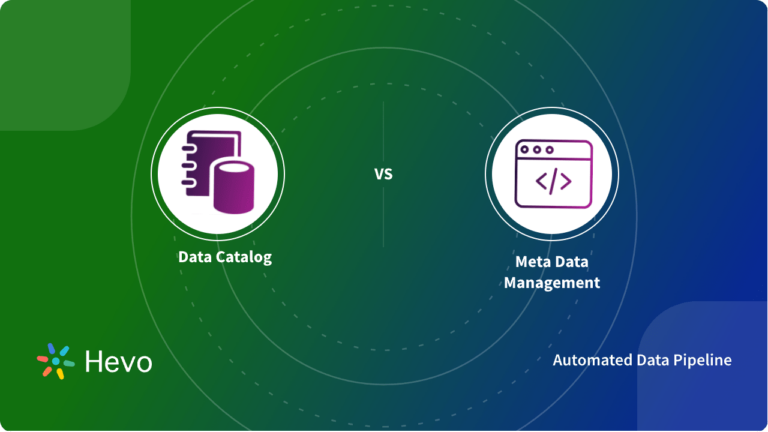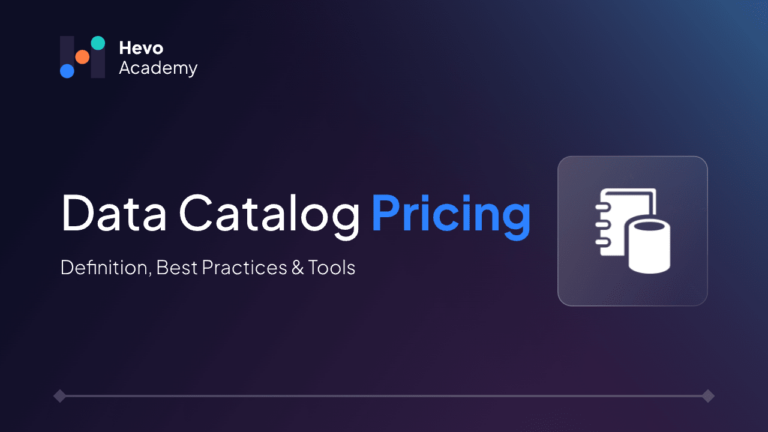In the modern world, where business environments change a lot more frequently than before, more organizations depend on a huge amount of information. However, it may become somewhat unmanageable when data is located in disparate systems and applications. Here, AI-enabled data cataloging presents a solution to this challenge. They assist in intelligent data discovery, metadata management, and improving the data governance function, hence solving the business intelligence problem of data management.
Table of Contents
A data catalog can be defined as a database of data assets with metadata about the data. It provides features to locate reliable data, comprehend it, and utilize it effectively.
This blog post will discuss and elaborate on the basic components, advantages, and tips on utilizing AI data catalogs and how they have evolved to optimally improve data management processes in any organization in the global digital environment.
What Is an AI Data Catalog?
A data catalog is an organization’s centralized repository for storing metadata and helps people identify exactly what data they require. But what about an AI-powered data catalog? Instead of employing this company as a catalog that uses AI, is it more of an AI system? Yes—and no.
While it’s true that AI enhances the capabilities of a data catalog, AI is not just making data catalogs better; it is also making them smarter with data and metadata, enhanced with contextual details, and making it easier to use to make the right choices.
An AI data catalog is a centralized structure which is self-served to manage and maintain the metadata of an organization’s data assets. It can learn and utilize machine learning algorithms to find, categorize as well as index data from different sources with the ability to keep track of data lineage and relationships.
Key Features of AI Data Catalogs
1. Automated Data Discovery and Classification
AI makes it easy to analyze data inputs from different sources in that the process of scanning, coding, and sorting them is done automatically.
2. Intelligent Metadata Management
Integrates with other forms of metadata to enhance, create, and update technical, business, and usage data at scale through AI.
3. Advanced Search and Data Lineage
Delivers potentially enhanced search functions that incorporate functionality such as natural language processing while the graphical interfaces for data relationships and transformations are credited.
4. Intelligent Search
Semantic search based on AI can provide a simple interface, like Google, for finding data. It complies with the natural language, synonym, and context search to allow the user to find relevant results.
Why Do Organizations Need AI Data Catalogs
AI data catalogs streamline data discovery, saving time and enabling faster decision-making. They improve regulatory compliance, enhance data quality, and reduce costs by minimizing redundancy.
- Data Discovery Efficiency: It can be used instead of traditional data searches that may take hours to conduct, suggesting time-saving and more effective decision-making.
- Regulatory Compliance: Enables improved management of data assets and assists in addressing compliance by providing a clear track of data lineage and usage.
- Cost Reduction: AI-powered data catalogs reduce data redundancy and excessive computation by helping organizations better understand their existing data.
- Enhanced Data Quality: Improves data quality through better documentation, standardization, and metadata management.
- Collaboration and Innovation: Encourages cross-functional collaboration and fosters innovation through shared insights.
Types of AI Data Catalogs
Enterprise Data Catalogs
They also offer means for cataloging, protecting, and managing data throughout large organizations, as well as addressing compliance issues.
Cloud-Native Data Catalogs
These catalogs are designed for the cloud and work best with cloud storage and services for each file and file type. They facilitate elastic and automatic resizing and offer real-time data visibility so organizations can control and find it within the cloud.
Open-Source Data Catalogs
These community-driven catalogs are flexible and user-friendly, making it possible for organizations to customize features in the catalog as deemed appropriate.
Domain-Specific Data Catalogs
These are designed to solve particular tasks and data types within particular lines of business, such as healthcare, financial, or retailing. As specializations, they provide better data handling and compliance to those industries.
How to Implement an AI Data Catalog in Your Organization

Step 1: Find the Data
People search for and recognize potentially useful data assets within the systems used across the organization, such as databases, data lakes, and cloud storage. This initiative establishes a basic catalog of recognized data resources and their locations within the organization.
Step 2: Evaluate the Data (Initial Assessment)
An initial examination of obtained information looks for elementary opportunities such as format, data completeness, and accuracy. This makes it possible to decide whether the data under consideration is suitable for the intended purposes.
Step 3: Evaluate the Data (Deeper Analysis)
This step involves quality control, which entails confirming the correctness, completeness, and accuracy of the collected data. All teams state the problems that will likely arise if an intervention is not made.
Step 4: Understand the Data
This step is necessary because groups cooperate in understanding the data context, correlations, and business relevance. It involves identifying the linkage between items of data and documenting business definitions.
Step 5: Prepare the Data
Treat raw data by cleaning and formatting it and adding metadata to the tables. This helps in structuring the data and making it fit into the organization’s standards as it prepares for an analysis.
Step 6: Analyze the Data
In this step, apply some type of analysis to derive useful information, to recognize patterns of trends and discoveries that can be useful for businesses.
Step 7: Share the Analysis
Present results in the form of written reports and use graphic displays to make the reports understandable to all the end users.
Step 8: Need More Data (Feedback Loop)
It enables organizations to go back to the data-finding stage if a team discovers that more information is required to solve a problem. Thus, teams can thoroughly analyze data and manage requirements well.
You can also check out the step-by-step process for building a data catalog, which involves just six easy steps!
Tools for AI Data Catalogs
Leading AI-Driven Platforms for Data Cataloging and Management are listed below:
1. Hevo Data
Hevo is a no-code, fully automated data integration tool that makes it easy to handle data and create catalogs. This type of data analysis offers real-time insights and can easily interface with several other data delivery systems.
2. Alation
Alation is built on data governance and enriches it with essential tools for teamwork, including effective data searching and management. It also includes AI suggestions to improve data exploration and decision-making.
3. Collibra
Collibra is the leader in data governance and privacy and offers solutions for organizations to maintain data compliance and regulations.
4. Google Cloud Data Catalog
Google Cloud Metadata is Google Cloud’s first-party metadata solution for finding, tagging, archiving, and protecting data across Google Cloud services.
You can also explore the 10 best data catalog tools according to G2 Ratings.
Benefits of Using an AI Data Catalog
- Accelerated Data Discovery: Automating the use of catalogs via Artificial Intelligence improves data search by providing results much faster and more relevant than the latter, making work easier for teams.
- Improved Data Quality: It also automatically verifies information to be collected and used to eliminate or reduce the probabilities of inaccurate data.
- Cost Savings: Thus, the organization increases efficiency and reduces operating costs by automating processes such as data classification and validation to maximize the utility of AI data catalogs.
- Enhanced Security: Thus, integrated features improve data security by increasing the monitoring, encryption, and regulation imposed on personal data.
Learn more about the benefits of data catalogs by understanding why your business needs an enterprise data catalog.
Challenges in Implementing AI Data Catalogs
The following are some of the challenges likely to be encountered while implementing AI-driven data catalogs.
- Integration Issues: Avoiding standardization with existing systems and processes is an important factor that needs some consideration.
- Data Quality: The quality of the data on sources is essential because it determines the rest of the process of cataloging.
- Employee Adoption: Employees must be professionally trained and motivated to accept a new system, which may take some time.
- Fixed Costs: There are serious cost concerns associated with using AI data cataloging tools. These refer to the costs incurred in software and infrastructure.
Best Practices for AI Data Catalog Implementation
- Engage Stakeholders: The members of the stakeholder map who may be involved include top management, the implementation team, consultants, business partners, vendors, and customers.
- Focus On Data Governance: Current specific best practices for managing data and set protocols that must be followed to guarantee quality, security of data, and compliance.
- Ensure Scalability: Choose an expandable solution so that it can meet the organization’s future needs and how it will grow in usage.
- Promote User Training: Conduct proper training initiatives that will enable someone to use it effortlessly upon the release of the AI data catalog.
Conclusion
In conclusion, AI-powered data catalogs are instrumental in changing how businesses interact with their data. They allow the organization to make decisions faster with the help of automating data finding, bettering the management of metadata, and implementing improved data governance. These catalogs do not only facilitate processes but also drive an organizational culture that encourages collaboration and innovation.
Higher data volumes and featuring data complexity rates make using AI-based solutions crucial for better data quality, increased compliance, and utilization of lower costs. Lastly, the use of AI data catalogs enables organizations to enhance their data, as well as promote efficiency, security, and business returns.
Ready to revolutionize your data management? Explore Hevo today and discover how our ETL platform can transform your organization. Book a personalized demo with us.
FAQs
1. What is the AI catalog?
An AI catalog is a system that uses artificial intelligence to match, sort, and arrange the necessary data effectively, maximally simplifying users’ work.
2. What is the best data catalog tool?
The best tool depends on organizational needs. Popular options include Hevo Data, Alation, and Google Cloud Data Catalog for their robust features and scalability.
3. What is included in a data catalog?
Data cataloging is an important aspect of managing and utilizing data. It comprises metadata, data lineage, governance policies and rules, a search and discovery interface, and collaboration.

